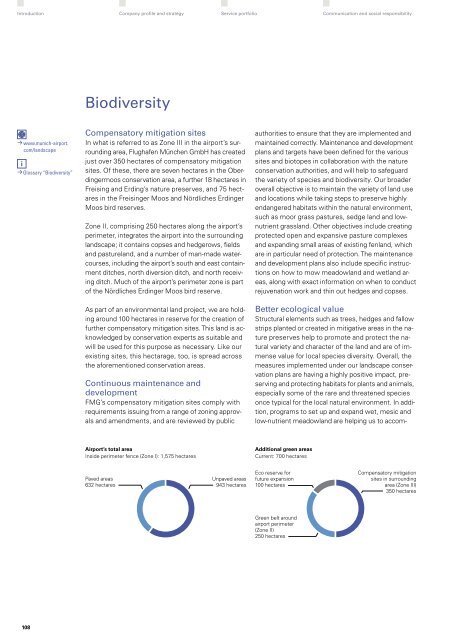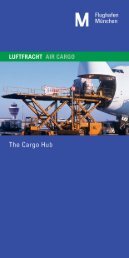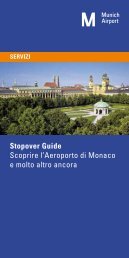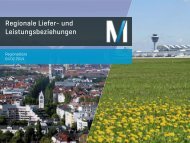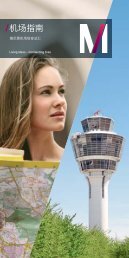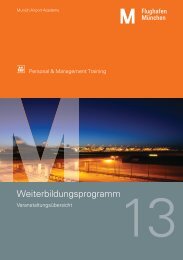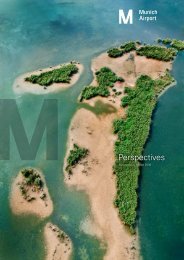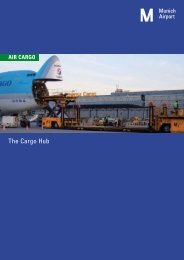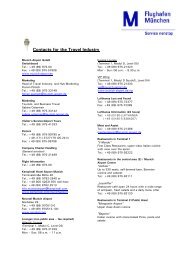"Perspectives 2011" - Sustainability and Annual Report (pdf)
"Perspectives 2011" - Sustainability and Annual Report (pdf)
"Perspectives 2011" - Sustainability and Annual Report (pdf)
Create successful ePaper yourself
Turn your PDF publications into a flip-book with our unique Google optimized e-Paper software.
Introduction Company profile <strong>and</strong> strategyService portfolio Communication <strong>and</strong> social responsibilityBiodiversity) www.munich-airport.com/l<strong>and</strong>scape) Glossary “Biodiversity”Compensatory mitigation sitesIn what is referred to as Zone III in the airport’s sur -rounding area, Flughafen München GmbH has createdjust over 350 hectares of compensatory mitigationsites. Of these, there are seven hectares in the Oberdingermoosconservation area, a further 18 hectares inFreising <strong>and</strong> Erding’s nature preserves, <strong>and</strong> 75 hectaresin the Freisinger Moos <strong>and</strong> Nördliches ErdingerMoos bird reserves.Zone II, comprising 250 hectares along the airport’sperimeter, integrates the airport into the surroundingl<strong>and</strong>scape; it contains copses <strong>and</strong> hedgerows, fields<strong>and</strong> pasturel<strong>and</strong>, <strong>and</strong> a number of man-made watercourses,including the airport’s south <strong>and</strong> east contain -ment ditches, north diversion ditch, <strong>and</strong> north receivingditch. Much of the airport’s perimeter zone is partof the Nördliches Erdinger Moos bird reserve.As part of an environmental l<strong>and</strong> project, we are holdingaround 100 hectares in reserve for the creation offurther compensatory mitigation sites. This l<strong>and</strong> is acknowledgedby conservation experts as suitable <strong>and</strong>will be used for this purpose as necessary. Like ourexisting sites, this hectarage, too, is spread acrossthe aforementioned conservation areas.Continuous maintenance <strong>and</strong>developmentFMG’s compensatory mitigation sites comply withrequirements issuing from a range of zoning approvals<strong>and</strong> amendments, <strong>and</strong> are reviewed by publicauthorities to ensure that they are implemented <strong>and</strong>maintained correctly. Maintenance <strong>and</strong> developmentplans <strong>and</strong> targets have been defined for the varioussites <strong>and</strong> biotopes in collaboration with the natureconservation authorities, <strong>and</strong> will help to safeguardthe variety of species <strong>and</strong> biodiversity. Our broaderoverall objective is to maintain the variety of l<strong>and</strong> use<strong>and</strong> locations while taking steps to preserve highlyendangered habitats within the natural environment,such as moor grass pastures, sedge l<strong>and</strong> <strong>and</strong> lownutrientgrassl<strong>and</strong>. Other objectives include creatingprotected open <strong>and</strong> expansive pasture complexes<strong>and</strong> exp<strong>and</strong>ing small areas of existing fenl<strong>and</strong>, whichare in particular need of protection. The maintenance<strong>and</strong> development plans also include specific instructionson how to mow meadowl<strong>and</strong> <strong>and</strong> wetl<strong>and</strong> areas,along with exact information on when to conductrejuvenation work <strong>and</strong> thin out hedges <strong>and</strong> copses.Better ecological valueStructural elements such as trees, hedges <strong>and</strong> fallowstrips planted or created in mitigative areas in the na -ture preserves help to promote <strong>and</strong> protect the na -tural variety <strong>and</strong> character of the l<strong>and</strong> <strong>and</strong> are of immensevalue for local species diversity. Overall, themeasures implemented under our l<strong>and</strong>scape conservationplans are having a highly positive impact, pre -serving <strong>and</strong> protecting habitats for plants <strong>and</strong> animals,especially some of the rare <strong>and</strong> threatened speciesonce typical for the local natural environment. In addition,programs to set up <strong>and</strong> exp<strong>and</strong> wet, mesic <strong>and</strong>low-nutrient meadowl<strong>and</strong> are helping us to accom-Airport’s total areaInside perimeter fence (Zone I): 1,575 hectaresAdditional green areasCurrent: 700 hectaresPaved areas632 hectaresUnpaved areas943 hectaresEco reserve forfuture expansion100 hectaresCompensatory mitigationsites in surroundingarea (Zone III)350 hectaresGreen belt aroundairport perimeter(Zone II)250 hectares108


